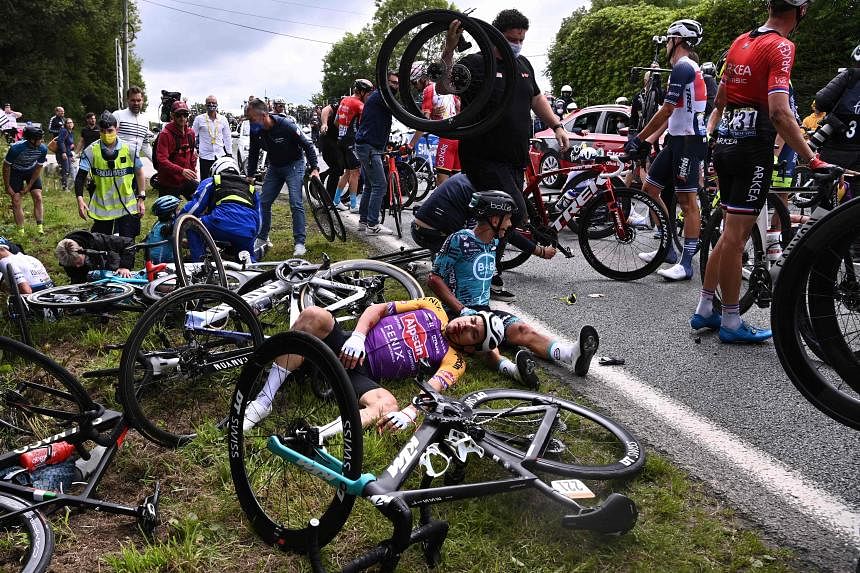The world is beautiful because it is full of the adventurous and insane and it’s always a pleasure to meet folks from this clan. Tightrope walkers who use no net. Climbing’s no-rope free soloists. Arctic ice swimmers. Tour de France cyclists.
How thin are your tyres, I ask Jonas Vingegaard on Saturday.
“28mm”, says the Tour de France champion.
How fast are you coming down slopes, which might be wet?
“Between 100 and 110 (kmh).”
We shudder at what they do but we’re transfixed by their ability to trust skill and wear pain. In the search for the finest versions of themselves, humans go to places of physical distress beyond our understanding. So when you meet them, you want to know, how does the mind work when you’re balanced on the thin edge of risk?
So, down the slope, at 100kmh, is there fear? Or only focus?
“No,” says Vingegaard, “I think at that point it’s only about focus. If you start thinking, ah, I might crash, then you brake.”
So is there a little bit of craziness in cycling?
“Yeah, for sure. You have to be a little crazy to be able to go with these speeds.”
Crazy sounds about right. Craziness is important to know if you’re a kid setting out on a dream. Sport asks hard questions and they’re answered by tough folks. Cyclists fall, for instance, the skin tears, dirt enters wounds, gravel gets embedded. And so in the shower, as Singapore national cyclist Calvin Sim reveals, he uses a “luffa sponge to clean out (the wound)“. Yup, it hurts.
On Netflix I recently saw a single episode of a series called the Human Playground. The whole planet is one, even the unforgiving desert. There’s a scene involving Amy Palmiero-Winters, a middle-aged woman, huffing up a dune during the Marathon des Sables, a 250km ultramarathon in the Sahara. She has a prosthetic leg and if her suffering is carved on her face then so is her drive. “My gift is the ability to endure,” she says.
Pain is fascinating because we can’t feel another athlete’s legs burn but we can feel ours. Limits are a personal thing, pushing them takes practice and pain is a by-product of desire. How far will you go? How far can you go? Wearing pain isn’t only about personality, it’s about circumstance. Who depends on you? What are you fighting for? Is winning close?
On Sunday, Mark Cavendish, the legendary Tour de France road sprinter, spoke almost casually about what he’d broken over the years. “Separated my shoulders and (fractured) a few ribs. Don’t know how many.”
This, Cavendish continued, “is our job to suffer like that”. It’s as if they’ve signed a contract with themselves: Want to win, have to hurt. “What you get at the end of it,” he says, “the rewards you get, outweighs it, so it’s worth it. You get the suffering, you get the lows, you also get the incredible highs.” The cause is worth the discomfort.
Eventually, as Emily Ortega, head, psychology programme, Singapore University of Social Sciences, says, “athletes learn to normalise pain. Being able to tolerate pain allows them to push harder and so they test and push their pain tolerance limits in training and competitions.”
Pain has degrees and types and athletes are always listening to their bodies. Hurting – sliding into the gravel – isn’t fun, but the other pain, of effort, is almost a craving. To find the limit, there must be payment.
Vingegaard told me on Saturday that the lungs hurt, so do the legs, but it’s what he subsequently said which reveals great athletes. “Actually, at one point you start to enjoy the pain. I mean, of course you don’t enjoy it while being in it. But anyway, you still enjoy it.
“Like for me, if I had a break of two weeks and I didn’t touch my bike, I start to miss the feeling of the pain in my legs. It sounds strange, but it’s just like it’s a different kind of feeling than when you hurt yourself.”
Always we talk of skill in sport, of topspin forehands and curling free kicks, of corners taken fast on cycles and fast-ducking boxers, of sixes hit deep into the stands and badminton drops which fall over the net like a sigh.
Hand-eye skills are delicious and yet it is often what we cannot see which is where the challenge of sport lies. The willingness to shrug off adversity, every training day, every competition ride. Victory lies in detail but also in the unvarnished truth of effort.
In the Netflix series, Palmiero-Winters, who cries because her cramps are so severe, says “pain is my playground”. So it is for cyclists. Their world aches, yet they endure. Their bodies are tuned, but it’s their minds which carry them forward. The road to masterpieces, they know, is lined with misery.


